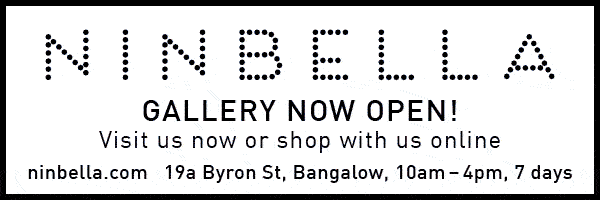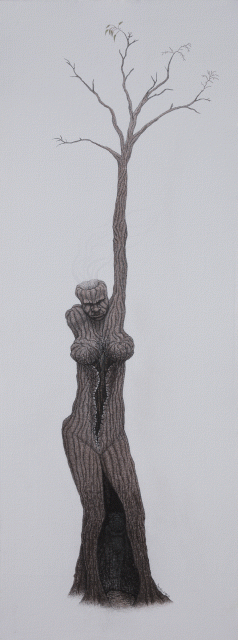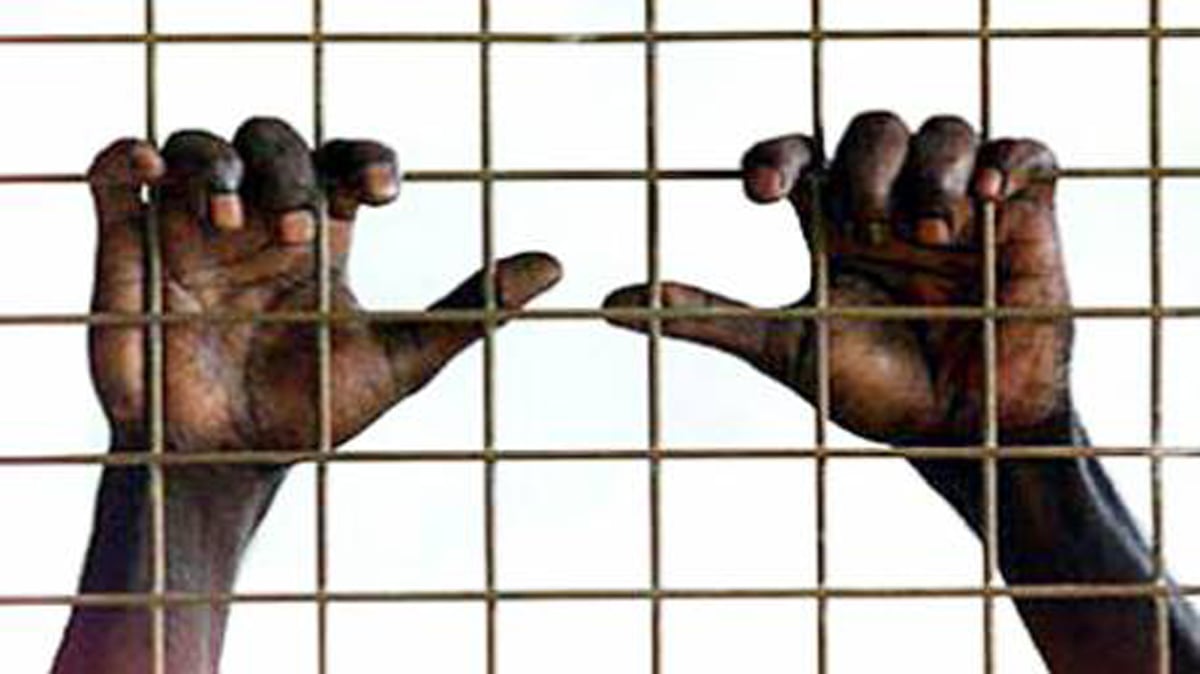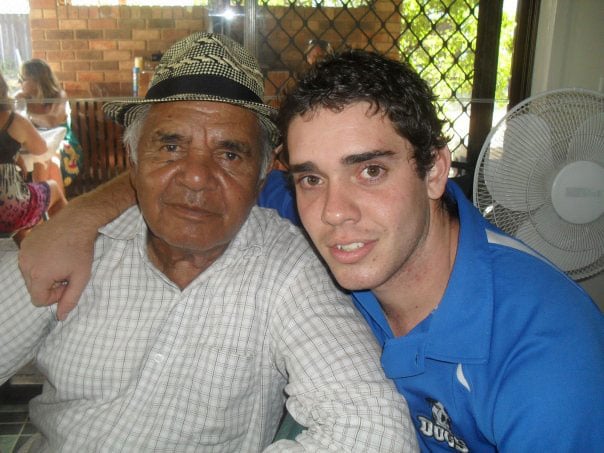
♦ Budgeram means story in Bundjalung language.

Bronwyn Bancroft
I acknowledge the Arakwal people, whose lands I live and work in.
What are we all afraid of? What is the fear that immerses us to such a degree that we become immobilised? I felt that fear in the initial days of the first wave of the pandemic called COVID-19. I watched all the news, and I was horrified and sad for the loss of life.
I retrieved my youngest child from Sydney and brought her to stay with me on the North Coast in Bundjalung country.
I watched as people talked a lot about this immunological catastrophe, the unseen enemy and the devastation that was affecting many countries across the world.
All of the news actually started to make me feel ill, so I turned off the news and tuned in to my life.
Paranoia, inertia, and depression
When the reality/not reality of this pandemic was initially announced, I was horrified that I might not see my family and friends again; that I could die without completing my art projects. I was locked into a compressed cell of paranoia and inertia, and I could not paint. I couldn’t hug my youngest for two weeks, and so I fell into a state of lethargy – gardening and reading – no creating.
After two weeks of procrastinating about the future, I started completing art-related projects, and I have now returned to the pace I love – flat out!
My daughter also ramped up her first experience in long distance education. She has created a world of fairies, the Minotaur, dragons and the seven deadly sins, a world conjured from a fertile imagination, in clay and coloured plasticine.

We were back! And the creativity that is our rock was embedded into every day. It made us happy, contented and definitely not fearful. Nothing prospers when fear surrounds our thinking, and this pandemic and the media reporting was elevated and unwieldy at times, creating confusion.
While I was trying to pull out of the depression I found myself in, I was also strategising for an organisation in Sydney called Boomalli Aboriginal Artists Co-operative when we were caught by COVID-19. My initial response, as the senior strategist for this 33-year-old arts organisation, was to close doors, separate staff, let casuals know we couldn’t hire and to start to work towards going online for our artists’ representation, looking after our people. We have a lot of underlying health issues with many of our members, and I was taking no risks.
We closed our Co-operative on 17 March, 2020. Since then, a small team of four have put a Mardi Gras exhibition online and our latest, ‘Not Young or Free’, where artists have responded to the arrival of Captain Cook in Botany Bay 250 years ago.
We also applied for every grant possible. While the amounts are tiny, we are grateful for any support. Over half of our membership live in regional areas of NSW and we are determined to keep the cycle of creating beating. We have succeeded in mounting two exhibitions, created ‘Meet the Artist’, and personal presentation of our members online as well as selling artworks online. It’s a whole new world for us.
The Arts in Australia have taken a severe beating from the Morrison government. Many funding agencies have had their budgets reduced dramatically. In these last few months, we have seen the prime minister not engaging on any issues related to saving a sector that employs over 600,000 workers and represents $100 billion to the economy, and which is pivotal to the wellbeing of humans.
Big Bad Artists
Why is it that the Arts are treated in such a paltry manner? Who is afraid of the Big Bad Artists? This government is. The government’s conservative and negligent attitude towards the arts is robbing this country of vision, of imagination, of hope and of creativity at a time when we need this as humans, to connect to ourselves, our surroundings and others.
When the Federal government amalgamated the Arts portfolio with infrastructure, I knew in the pit of my stomach that our stories were being sidelined by a government committee that cared little for the creativity that we all enjoy. Art galleries, theatres, cinemas, art classes, professional artists and amateurs who fill our boring and grey existence has once again been dismissed as trivial and irrelevant.
In COVID-19, the Australian Bureau of Statistics revealed that 53 per cent of small arts and recreation businesses have closed their doors, some will never open. We will not know the depth of loss, but time will peel back the layers of devastation that has occurred.

How to tell a different story?
For Boomalli, we’ve never had large amounts of money, and we have had to fight for survival. This takes courage, determination and skill. With volunteer love and dedication to making change happen for Aboriginal artists in NSW, we continue to succeed.
At the higher/better funded end of the arts spectrum are organisations that have created artistic hubs for everyone. One of these very dominating art complexes is Carriageworks in Chippendale, Sydney, which has now entered into voluntary administration when $2.5 million of funding was withdrawn by Create NSW.
Australian galleries and museums were forced to close on 25 March, 2020 and the galleries, museums, and art precincts are reeling from the shock. The financial distress caused by COVID-19 will continue for years and the experiences of the pandemic show the vulnerability of the arts sector.
How do we begin to weave a different story – story that allows all of us to be involved, loved, cared for and thought of as an asset, not a liability?
Change can happen overnight as we have witnessed in the recent months. People living in poverty on Newstart were granted a reprieve.
Domestic violence (DV) issues again reared its ugly head in the lockdown. Governments have previously dismissed the voices of DV victims; but because we were all watching funding may be increased to help challenge this.
We also saw the disparity and lack of equity through a lockdown lens – as children without technology and support have suffered and may never be able to recover their momentum.
There are so many holes in the fabric of this society, and I know we must repair them. We can assist by looking after others, we can be unselfish, and we can alter the way we live, now and in future. We can tackle climate change, we can provide a universal income that will diminish poverty and the inequality that exists today, and we can provide public housing for disadvantaged people.
Stop funding private hospitals, and put our taxpayers capital into public hospitals. Stop funding private schools, and fund public creative centres for public school education.
To find new pathways imagination and curiosity has to be cultivated and this knowledge needs to be shared. We have all experienced enormous waves of change in our lives. We are at a meeting point because we accepted our vulnerability and our care for others, which was paramount in our thoughts.
I want change. If we emerge from this eerie existence and don’t continue to agitate and petition for change, then we are lesser people for it.

Author
Dr Bronwyn Bancroft is a proud Bundjalung Woman and Artist. Bronwyn has been exhibiting nationally and internationally for over three decades.
Bronwyn has a diverse Artistic practice including public art commissions and imagery design for private commission. Bronwyn illustrated her first children’s book, The Fat and Juicy Place in 1992. Since then, Bronwyn has authored and/or illustrated 41 children’s books.
Bronwyn was the Australian finalist for the Ezra Jack Keats Award for Excellence in Children’s Book Illustration in 1994.
In 2010 Bronwyn received the Dromkeen Medal for her contribution to Australian Literature and in 2016 was the Australian Finalist for the Hans Christian Andersen Award (Illustrator). Bronwyn is currently nominated for the 2020 Astrid Lindgren Memorial Award.
Bronwyn holds board positions with Australian Indigenous Mentoring Experience (Director) and the Commonwealth Bank Indigenous Advisory Council. Bronwyn has been a volunteer senior strategist at Boomalli Aboriginal Artists Co-operative since 2009.
Bronwyn has a Diploma of Visual Arts; two Masters degrees from the University of Sydney, one in Studio Practice and the other in Visual Art. Bronwyn was awarded her Doctor of Philosophy (PhD) in 2018.
More Storylines articles
Invasion Day – time to create unity through recognition and justice
As 26 January approaches our communities are once more gripped by polarised views of the date.
If not now then when?
In 1901, when Australia’s Constitution was originally determined, there was no direct mention of First Nations people. In fact, it was designed to deliberately exclude us.
The moment we can change the course of history
For decades, Aboriginal and Torres Strait Islander people have been campaigning for change to the current political system in Australia. Many incremental changes have led us to this moment in history...
Storylines – The Voice, it’s time
For generations, First Nations people have consistently and persistently pointed to self-determination as being essential in making meaningful difference in the lives of our people.
Storylines – Upcycle the festive season
♦ Budgeram means story in Bundjalung language. Here comes Christmas, the festive season; the year is drawing to a close and we put the icing on the year with the biggest celebration in our collective calendar. For many it’s a problematic time...
Storylines – Boomalli Aboriginal Artists Co-operative
♦ Budgeram means story in Bundjalung language. Thirty-five years ago, ten Aboriginal artists gathered to create an Aboriginal Artists Co-operative in Sydney, the place of first point of contact with the English in 1788, when Captain Cook proclaimed that the land was...
Storylines – Belonging places
Belonging is a feeling of security and support we experience when we experience a sense of acceptance and inclusion in community. Belonging is a sense of being connected to something greater
Storylines – Working with mob
Many are asking ‘who do I talk to?’ if I want to work with mob? Taking the time to yarn, engage and build relationships is key.
Storylines – The Voice of the voiceless
My grandfather would often tell me a story. A story about a community. This community was self-sufficient, self-reliant, and self-determining of their own lives.
Storylines – Returning to old ways of housing
Kinship and Country obligations for mob resulted in bands, or groups of families living together and sharing everyday life, prior to colonisation.












